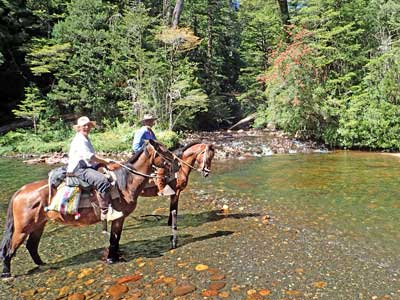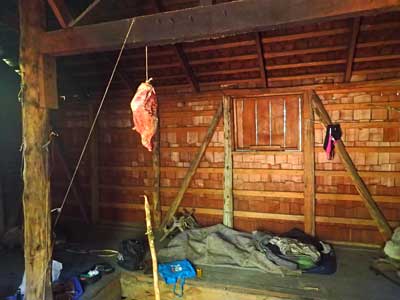Cochamó Valley horse trekking - Crossing the Cord illera Grande

Caramor - sailing around the world
Franco Ferrero / Kath Mcnulty
Thu 8 Dec 2016 20:34
41:27.53S 71:57.31W Señora Ida fed us a good breakfast while Ciro saddled the horses and prepared the saddle bags. We were introduced to Grano de Oro (Grain of Gold), Franco's mount and to Estrella (Star), mine. Both seemed very calm and stood quietly while we loaded up. As soon as we jumped on their backs, though, they were off.  Franco, Ciro, Ida and Kath  Map of the route (courtesy of the Municipality of Cochamó) Morro set the pace as we headed out of Cochamó on the tarmac road. Grano, Estrella and La Gringa had to break into a trot every now and then to keep up. We are talking western style riding here, you ride the trot sitting, something we find very hard to do. As we bounced down the road, we reckoned we had many painful hours ahead of us to figure out the correct way. We asked Ciro for top tips: "Just relax into the rhythm of the animal" he offered helpfully, as his bum barely lifted from the saddle. The guy in Brazil had said the same thing but we were still none the wiser. (We later found out that Ciro's horse Morro never trots, he simply walks fast which is much more comfortable for the rider.)  Beehives on the outskirts of town - honey from the ulmo (Eucryphia cordifolia) is popular and delicious We turned left onto a dirt track and soon we were heading uphill towards La Junta, badged 'the Yosemite of South America'. Above the forest, startling granite peaks, a thousand metres tall, reach up towards the bright blue sky. The area was 'discovered' twenty years ago by foreign climbers and is becoming increasingly popular every year. Franco looked pensive, he was working out how many extra ropes we would need to scale one of the walls. The track was steep and rough and we were impressed that the horses could tackle such terrain (later we realised that had been the easy bit). Just before crossing the first ridge, Ciro called home on his VHF radio, we would soon lose signal.  Phoning home (the red bag contains a chainsaw) We met a few walkers on the trail and rode through the main campsite at La Junta which was quiet, it is still early in the season. The next gate led to Ciro's land and his shack in the woods. The horses were glad to get the weight off their backs and rolled around in the dust to wipe the sweat off their skin. I too was pleased we had arrived, a large belt of pain enclosed my waist, muscles I didn't know existed, ached. Maybe booking a nine day trek hadn't been such a good idea after all.  The waterfall known as 'the slide' with one of the La Junta walls above Ciro made a hearty soup and then set about building the fire to prepare the 'asado al palo'. He had brought half a lamb from Cochamó and we were going to spit roast it. He packed us off to the 'beach'. We didn't quite believe him but sure enough, a short distance from his lodge, we found a beautiful river with a small white sandy beach. Franco was looking forward to a swim ... until he dipped his toe in, then settled for a wash. I swam around in the cold water until I got icecream head. Tired muscles relaxed, we fell asleep in the warm sunshine. When we got back to the camp, Ciro had put our tent up for us.  Calbagatas Cochamó's lodge at La Junta  The Cochamó River The next morning we rose to another day of glorious sunshine. Our destination was the refuge 'El Arco' named for the nearby natural stone arch over a waterfall. Once back on Estrella, I didn't ache quite so much, maybe I would survive after all. The trail meandered through native woodland, sometimes skirting the edge of small open plots of private land. The route we were following is an ancient passage over the Andes, first discovered by the Spanish colonists in 1883 but used by native Americans for at least 1,500 years before. The hunting tribes from the Patagonian plains would cross over to the Pacific to trade with the canoe people. So many people and horses have travelled the route that in places the path has sunk well below the level of the surrounding ground.  The sunken path We stopped for lunch near a hut. Ciro told us that it was the first time he had ridden the very steep boardwalk with clients and we took it as a compliment. The land around the hut was for sale for Ch$80,000,000, four times its agricultural value and the owner is hoping a foreigner will buy it. Our horses rested, we set off again, only to find our path blocked by a large fallen tree. Ciro scouted around but there was no way through. He set to work with the chainsaw to clear a new route through the scrub.  Ciro clearing a path (I suppose his leather riding gaiters might deflect the saw should it slip) Meanwhile the Gaucho got on with some serious cowboy work.  The Gaucho hard at work The trail became more serious; steep ups and downs with big drop offs and slippery soil. The horses forever amazed us, they carefully chose their route through the maze of vegetation, always taking care to place their hooves. Estrella was particularly clever, she never blindly followed the horse in front, as I have known many horses do. Instead she constantly assessed the ground ahead, picking the easier route. This did mean I had to watch out as sometimes she passed under low branches or too close to tree trunks which could take your kneecaps off. In places the path had been 'improved' with poles and planks, while the other horses had two hooves on the board and two in the mud, Estrella walked daintily with all fours on the timber, as if down the catwalk. Grano wasn't quite so nimble and relied on brute force to, somehow, get his hindquarters over the obstacles. As we gained altitude, the trees became taller. Ciro pointed at some of the larger ones, "Coigüe" he said. It was hard to believe that these giants, 40m tall with a great girth, were indeed the same species as the bonsais of the southern channels.  Coigüe Ahead, a tree with a different bark, more stringy and as we got nearer we saw how tall it was; our first alerce, several thousand years old. We passed many more over the next few miles, including young ones and seedlings. Although the tree is rare, it is still reproducing.  Alerce Another river crossing and we came to the stone arch framing a waterfall. The refuge was a short distance up the bank. We unsaddled the horses but when Franco tried to remove Grano's bit, he found he couldn't. Somehow the horse had got its tongue stuck through the metal ring. The end of the tongue was swollen and starting to go black.  The arch  River crossing Ciro came over, he had never heard of this happening before. With Franco's help they tried to work the tongue back out. One man was hanging onto the tongue while the other pulled on the ring to dislodge it. Grano stood imperturbable, bright enough to understand that these two were trying to help him. "Gracias a Dios es un caballo manso" (Thank God he's a calm horse) muttered Ciro who was beginning to think he would have to cut the tongue off. Ciro tried another method, he rolled the tip of the tongue and slowly eased it out. Relieved, Grano ran off with his tongue still hanging out. No permanent harm had been done and a couple of hours later he was back to normal. For the rest of the trip he had Estrella's bit.  The small metal ring on the bit with Franco's hand for size comparison Inside the refuge, half the floor was missing (or so I thought) until Ciro set about lighting the fire in the gap. The cowboys or 'huasos' as they are called in Chile would sleep on the raised floor around the fire pit. Patagonia, particularly in the mountains, can be very cold at night.  The Arco River was as cold as the Cochamó so Franco watched me from the bank The horses had wandered off to the pasture and we put our tent up nearby. We didn't fancy the dark, smoke-filled refuge on such a pleasant day.  Ciro drinking 'mate' (a strong bitter herbal tea sipped through a metal straw and usually shared with friends) while the lamb roasts  Huaso encampment with tomorrow’s dinner hanging There wasn't a cloud in the sky while we prepared the horses and I was puzzled that Franco insisted on packing a warm fleece in the day bag. He must have felt it in his bones for shortly after setting off, the sun disappeared and it began to rain. We were riding across the steepest terrain yet, as we crossed over the high pass. Ciro asked us to dismount for a couple of sections that were particularly arduous. At one steep descent, Grano looked back at Franco as if to say "Are you sure you don't want to walk this bit? It's rather tricky, you know.”  A boardwalk  We walked this section By Lago Grande (Big Lake) we stopped for a bite to eat, in the rain. Despite the waterproof ponchos, we were cooling down. I regretted not keeping my new woollen poncho handy, it was at the bottom of the large sacks on La Gringa's back.  “It’s a dog’s life!" One more ridge and we headed down towards Lago Vidal Gormaz (named after a Chilean surveyor who mapped the area). We had crossed the main cordillera. Our horses trotted contentedly across the flat pasture, greeted by the neighs of the local horses. A short way down the eastern side of the lake we came to the homestead of Carloncho and Margarita. We would spend a couple of nights here to rest the horses.  Fire was used to clear the land  Lago Vidal in the distance |